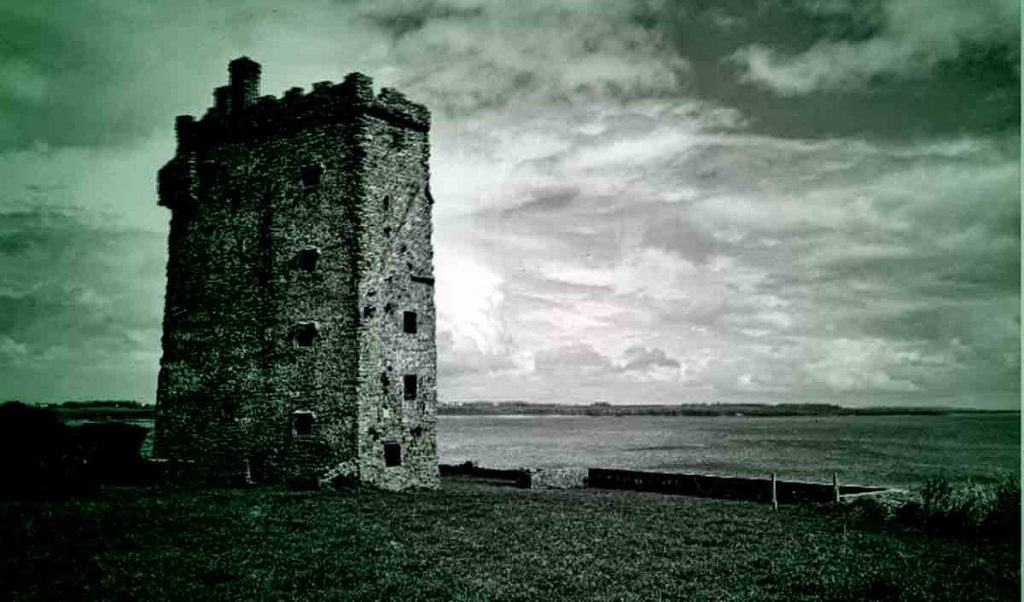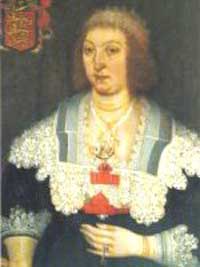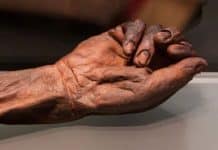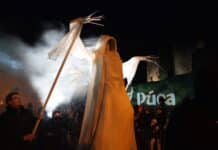County Clare has a landscape so ethereal that it was used for Harry Potter and the Half Blood Prince, ANN MASSEY tells us why the scenery is not the only otherworldly reason to visit County Clare.

Red Mary and Leamaneh Castle, The Burren, County Clare
Close to the village of Kilfenora in County Clare, made most famous by the TV series Father Ted, stand the ruins of Leamaneh Castle. Originally built as a five storey tower house circa 1480, by the O’Brien clan, Leamaneh translates as ‘The Horse’s Leap.’
In the mid sixteenth century Murrough O’Brien surrendered his title to Henry VIII and was rewarded for his loyalty to the crown by being named the 1st Earl of Thomond. After just a few years Donough O’Brien inherited the castle until he was hanged as a rebel in Limerick.
In 1639 grandson Conor O’Brien married a woman named Máire MacMahon, known as Red Mary for her fiery hair and aggressive demeanour. Her first husband had died young and she became a wealthy woman from the estate and together they used the money to build a mansion onto the tower house at Leamaneh Castle.
Máire accompanied her husband on raids against English settlers through Munster, however on one occasion she remained home, Conor was gravely wounded at Inchicronan. When he was brought back to the castle, Máire called from the parapet that no dead men were welcome in her house, although on realising Conor was still alive she granted entrance and stayed at his side until he died a few hours later.
Red Mary had no intention of surrendering her lands to Cromwell and losing her status, so Conor O’Brien’s wife took a carriage into town and announced she would wed any English Officer who wished to have her.

The ruthless widow married an Officer, kept her estate and continued to preside over it with an iron fist. Not known for her patience Red Mary would hang any servant she deemed insubordinate, the men by the neck and the women by the hair.
Having made many enemies, her cold-blooded character caught up with her and Máire was apprehended, placed in a hollow tree and left to starve to death.
The gruesome skeletal spectre of Red Mary can be seen haunting the ruins of Leamaneh Castle today, refusing to leave the home she was prepared to hold on to at any cost.
The Phantom Island of Kilstuitheen, Liscannor Bay, County Clare
Between Lahinch and Spanish Point lies Liscannor Bay and within that an expanse of uneasy ocean that hints at the mystery that lies beneath.
Kilstuitheen in County Clare was a magnificent place with golden turrets on castles and golden spires on churches, all built to reflect the wealth of its people and particularly the Chieftain and his clan. After defeat in battle, a massive tidal wave buried the island below the angry waters and all the inhabitants perished.
A golden key belonging to the King that opened the door to his domain was lost during the battle, later believed to be buried beneath a monolith on Mount Callan. When the key is found it is said that Kilstuitheen will rise up from the depths of the sea and the Chieftain will rise to lead his people once again
.
Fisherman have said they have seen glimpses of the city beneath the troubled water and every seven years Kilstuitheen upsurges just enough to be seen from the beach at Lahinch, however be warned – if you sight the lost island from shore, it is said you will not live to see it rise again.
Coastal Clare has been victim to the wild Atlantic since ancient times with earthquakes and tidal waves documented centuries ago. On the edge of the bay forests and bogs are submerged and Mutton Island which had been one, was split into three during the tsunami of circa 800 AD.
With that in mind, is the notion of a lost island beneath the waves that far-fetched?
Mermaid Curse of Newhall and Killone Lake, Ennis, County Clare
On the Newhall Estate, on the edge of Killone Lake stand the ruins of Killone Abbey. Founded in 1180 AD by the King of Munster, Donal Mor O’Brien, the Abbey was home to the Augustinian nuns until it became abandoned during the seventeenth century. Newhall House was established in the late 1700’s and the Abbey became a part of the estate.
During this time, the crypt was used to store wine and a servant noticed that it had begun to go missing. Standing guard with knife in hand, he was astonished to see the culprit was none other than the mermaid of Killone Lake. She waited until after dark and entering the crypt via the lake, she was helping herself to the wine it held.
Outraged, the servant stabbed the mermaid repeatedly and with her life force draining away she dragged herself bleeding to the edge of the water where she died, sinking to the depths of the lake. Her blood spilled out, turning Killone Lake crimson in the night.
The legacy of the mermaid is that the lake will turn red every forty years or when ownership of Newhall changes hands. Whether iron shale or a mermaid’s curse, the lake and ruins remain for you to find out for yourself.
Evil Spirit at McMahon’s Castle, Carrigaholt, County Clare
Now just the shell of its former five storey grandeur, the castle in Carrigaholt still holds onto one thing very tightly and that is the malevolent spirit sealed within its walls.
Built in the late 15th century by the McMahon clan, they denied aid to the Spanish Armada as they landed in 1588 and found themselves subject to months of attack. Finally yielding to the Fourth Earl of Thomond, they were hanged in contradiction of the surrender agreement and the castle became the property of Donal O’Brien until all lands were forfeit to the crown.
Did all the years of conflict and death leave a bad energy in McMahon’s Castle? Whatever evil spectre remained, it was deemed so wicked that it was sealed within a chamber and not disturbed – until the 1920s.
An exorcist had the room unsealed and climbed down inside it with the intention of ridding McMahon castle of its wicked entity, however his body was found the following morning, stone cold and face set in a rictus of horror. The chamber has been impenetrable ever since.
St Senan, The Sea Serpent and Spirits of Scattery Island, Kilrush, County Clare
Scattery Island, named after the sea creature who tormented the inhabitants, lies a few miles off the shore of Kilrush. Sometime before the 6th Century, the island dwellers were being terrorised by a Peist or Sea Serpent called the Cathach.
St. Senan, himself a healer prophesised by St. Patrick, was visited by the Archangel Michael and told how to banish the monster, so he climbed to the top of the highest hill and called to the Cathach. He faced the monster and ordered it in the name of the Trinity to leave and never return. The sea creature retreated and didn’t stop until it reached the deep dark waters of Doolough, The Black Lake in County Mayo.
St Senan then founded monasteries and churches on Scattery with the stipulation that no woman should ever reside on or set foot upon the island. Miracles were said to have been performed, the Holy Well had curing waters and it is said that even now St Senan’s grave has healing powers to those who attend it.
Despite Viking attacks and the abandoning of the monasteries during the reign of Elizabeth I, many of the buildings remain accessible, even in their various ruined states. At the turn of the 19th Century a fisherman found himself needing sanctuary from a heavy storm and took refuge on Scattery. As it was a Sunday he went into the church to pray.
As he knelt eyes closed, he heard voices and looked up to see monks and priests in ceremonial garb around the altar. Terrified he closed his eyes tightly again and prayed feverishly to be rid of the spirits before him. When he opened his eyes they were gone, the clouds and birds passing over the roofless ruin.
The island became inhabited once again in the 1800s by the captains of the Shannon and their families, seemingly protected by St. Senan from Ireland’s troubles as they survived political turbulence, the Great Famine and economic ruin.
Scattery Island saw the last of its residents leave in the 1970’s and the village known as ‘The Street’ together with the churches, castle and monastery remain one of Ireland’s most prominent ‘Ghost Towns.’
You can take a boat from Kilrush to Scattery and wander the ghost town yourself. Do mind the waters in case the Cathach is trying to return home and if you pray in the abbey ruins with your eyes closed, remember you may not be alone when you open them.
Have you seen a ghost in County Clare, Ireland? Tell us about in the comments section below!







